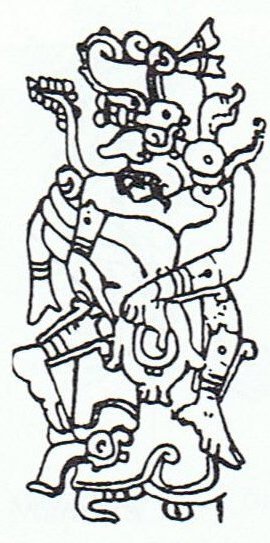The Manaia is traditionally believed to be the messenger between the earthly world of mortals and the domain of the spirits, and its symbol is used as a guardian against evil. In this form, it is usually represented in a figure-of-eight shape, the upper half culminating in a bird-like beak ..." (Wikipedia)
Why should it be necessary to have a separate calendar for the year? The pattern of the month is good enough to serve also as a map for the year. Life is 'spreading out' (horahora) when Moon draws the 'sea' aside in early spring, when the season of 'water' is 'evaporating'. It is like ebb and the 'tree' will grow. Then the 'sea' will once again send a 'flood', but at the end 'land' is triumphantly rising again: ... Now do I see / the Earth anew / Rise all green / from the waves again ... / Then fields unsowed / bear ripened fruit / All ills grow better ... I imagined hupee was a picture of the 'cosmic tree', and we can now guess the locations of our 2 examples in time-space:
20 is obvious, and maybe the picture shows the tree as 'exhausted' (pau), with branches hanging low. In Qa6-32 on the other hand, where 6 * 32 = 192, time has come for 'climbing the tree':
In Mayan iconography the 'Rain God' is looking back - he has reached to his limit. There is no return from 'the tree' however much he tries to turn around. He must be initiated and changed from an infantile raw beast into a cultivated member. He has reached manhood:
According to the geography of Easter Island hupee in Qa6-32 should be at position 17 (equal to the number at Kulu in the Hawaiian calendar):
The preceding item is number 16, and we know it indicates the last item in a sequence, and then follows the first item in next sequence. Consequently it is no surprise that item 17 should begin with a capital letter. There are 4 'tree' stations (17-20), beginning with Opata roa and ending with Hanga Ohiro. We can alternatively reach 24 by counting from Kane:
The season of preparation (before 'climbing') ends at Hanga Kuokuo (where 4 + 16 = 20). Indeed we can find a haga rave glyph before the first day of 'climbing':
Tagata in Qa6-35 is glyph number 240, and he has a single mata as head. The first half of the year ('the spring beast') apparently ends here (240 / 2 + 64 = 184 = 368 / 2). The following hakaturou has developed a 'joint' from 'colliding with earth': ... The ground was rapidly approaching. The ancestor was still standing, his arms in front of him and the hammer and anvil hanging across his limbs. The shock of his final impact on the earth when he came to the end of the rainbow, scattered in a cloud of dust the animals, vegetables and men disposed on the steps. When calm was restored, the smith was still on the roof, standing erect facing towards the north, his tools still in the same position. But in the shock of landing the hammer and the anvil had broken his arms and legs at the level of elbows and knees, which he did not have before. He thus acquired the joints proper to the new human form, which was to spread over the earth and to devote itself to toil ... Opata roa means the 'long ravine' according to Barthel 2. As for mana aia: "The additional name ('mana belongs to him'?) is similar to the explanation given for the place Roro Hau. One is reminded of Manaia, which in MAO. is the famous motif for wood carvings and in SAM. is the title 'the beautiful one' given to the favorite son of the chief (Krämer 1902, Vo. 1:479)."
|
||||||||||||||||||||||||||||||||||||||||||||||||||||||||||||||||||||||||||||||||||||||||||||||||||||||||||||||||||








